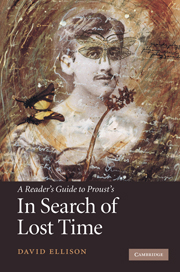Book contents
- Frontmatter
- Contents
- List of illustrations
- Preface
- Acknowledgements
- Chronology
- Introduction: At the threshold of Proust's novel
- 1 Du Côté de chez Swann [The Way by Swann's]
- 2 A l'Ombre des jeunes filles en fleurs [In the Shadow of Young Girls in Flower]
- 3 Le Côté de Guermantes [The Guermantes Way]
- 4 Sodome et Gomorrhe [Sodom and Gomorrah]
- 5 La Prisonnière [The Prisoner] and Albertine disparue [The Fugitive]
- 6 Le Temps retrouvé [Finding Time Again]
- Notes
- Select bibliography
- Index
4 - Sodome et Gomorrhe [Sodom and Gomorrah]
Published online by Cambridge University Press: 05 August 2012
- Frontmatter
- Contents
- List of illustrations
- Preface
- Acknowledgements
- Chronology
- Introduction: At the threshold of Proust's novel
- 1 Du Côté de chez Swann [The Way by Swann's]
- 2 A l'Ombre des jeunes filles en fleurs [In the Shadow of Young Girls in Flower]
- 3 Le Côté de Guermantes [The Guermantes Way]
- 4 Sodome et Gomorrhe [Sodom and Gomorrah]
- 5 La Prisonnière [The Prisoner] and Albertine disparue [The Fugitive]
- 6 Le Temps retrouvé [Finding Time Again]
- Notes
- Select bibliography
- Index
Summary
Nearly as lengthy as Le Côté de Guermantes, its successor volume, Sodome et Gomorrhe, was published in two parts, the first in 1921, the second in 1922 just a few months before Proust's death. This fourth volume of the novel was the last one that Proust was able to complete, and it bears all the signs of a careful and symmetrical composition. Divided into four chapters, each of which is preceded by short references to the broad outline of the plot's development, Sodome et Gomorrhe exhibits a clear structural design and was obviously intended by its author to be as reader-friendly as possible in its formal presentation, especially because the content of the volume was bound to shock and disconcert many of its readers in 1922.
The two long chapters of Sodome et Gomorrhe, chapters 2 and 3, are framed by two much shorter chapters, each of which explores the complexity of human sexual relations in ways that were to revolutionize European literature in the twentieth century. In chapter 1, in an elaborate, rhetorically complex and highly theatrical scene, Proust paints a picture of male homosexual relations centered on the Baron de Charlus, whose proclivities now reveal themselves with utmost clarity to the narrator. Significant sections in chapters 2 and 3 are devoted to an analysis of Charlus's often contradictory and outrageous behavior, seen now in the light of his homosexual identity.
- Type
- Chapter
- Information
- A Reader's Guide to Proust's 'In Search of Lost Time' , pp. 110 - 135Publisher: Cambridge University PressPrint publication year: 2010



